1994 CHEVROLET S10 air condition
[x] Cancel search: air conditionPage 298 of 340
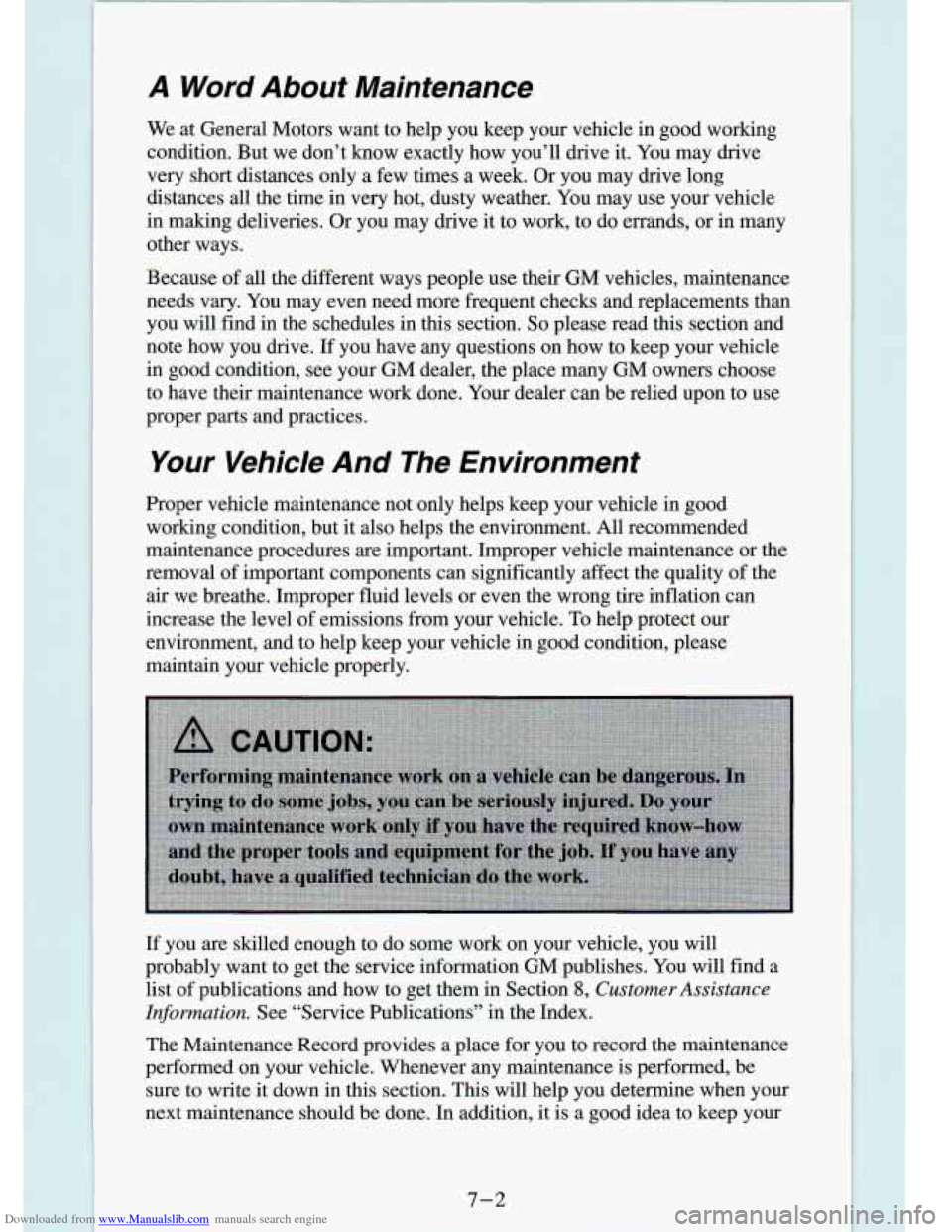
Downloaded from www.Manualslib.com manuals search engine A Word About Maintenance
We at General Motors want to help you keep your vehicle in good \
working
condition. But we don’t know exactly how you’ll drive it. You may drive
very short distances only a few times a week. Or you may drive long
distances all the time
in very hot, dusty weather. You may use your vehicle
in making deliveries. Or you may drive it to work, to do errands, or in many
other ways.
Because of all the different ways’pWple use their GM vehicle\
s, maintenance
needs vary. You may even need more frequent checks and replacements than
you will find in the schedules in this section.
So please read this section and
note how you drive. If you have any questions on how to keep your vehicle
in good condition, see your GM dealer, the place many GM owners \
choose
to have their maintenance work done. Your dealer can be relied up\
on to use
proper parts and practices.
Your Vehicle And The Environment
Proper vehicle maintenance not only helps keep your vehicle in good
working condition, but it also helps the environment. All recommended
maintenance procedures
are important. Improper vehicle maintenance or the
removal of important components can significantly affect the quality of the\
air we breathe. Improper fluid levels or even the wrong tire infla\
tion can
increase the level
of emissions from your vehicle. To help protect our
environment, and to help keep your vehicle in good condition, \
please
maintain your vehicle properly.
If you are skilled enough to do some work on your vehicle, you
will
probably want to get the service information GM publishes. You will find a
list of publications and how to get them in Section
8, Customer Assistance
Information.
See “Service Publications” in the Index.
The Maintenance Record provides a place for you to record the maintenance
performed on your vehicle. Whenever any maintenance is performed\
, be
sure
to write it down in this section. This will help you determine when your
next maintenance should be done. In addition, it is a good idea to keep your
7-2
Page 299 of 340
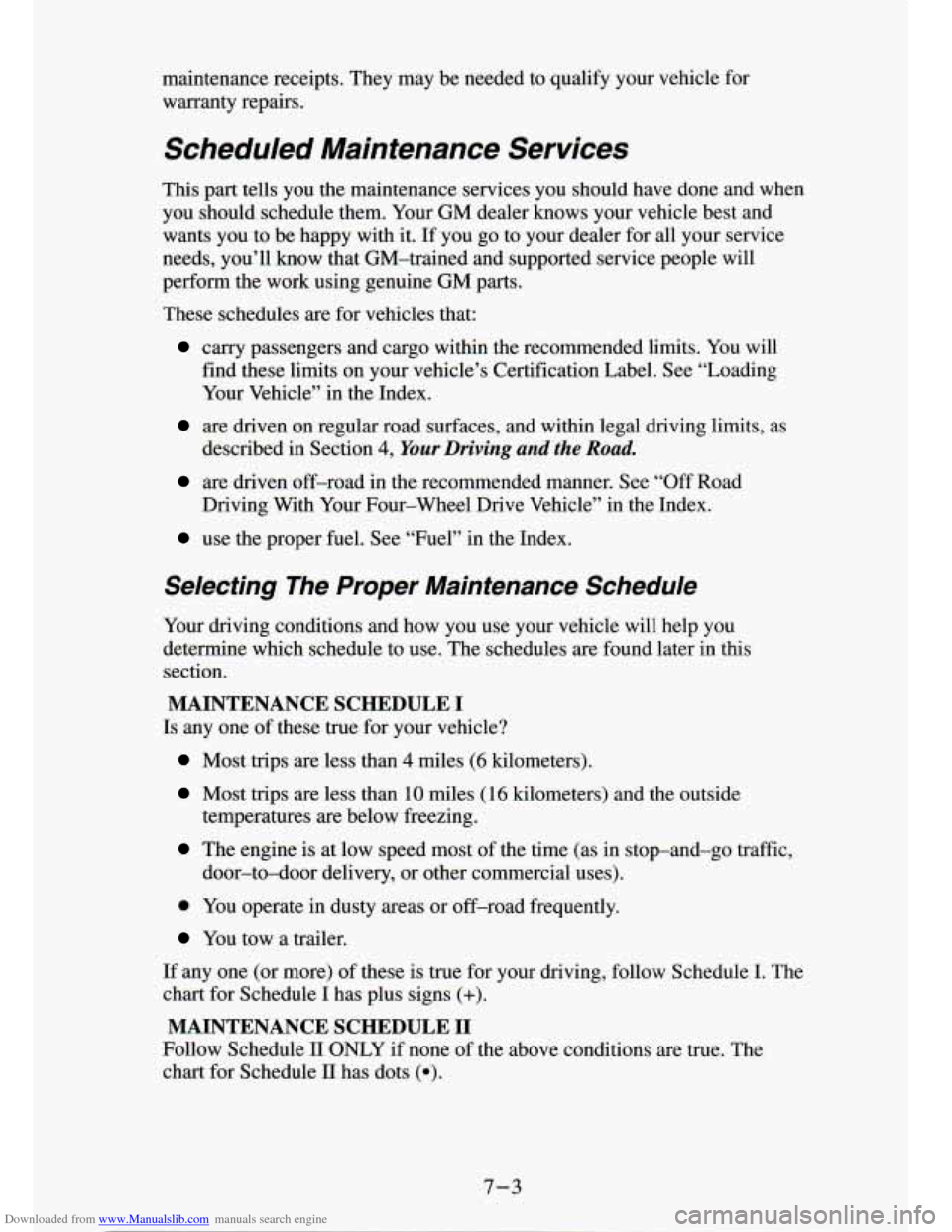
Downloaded from www.Manualslib.com manuals search engine maintenance receipts. They may be needed to qualify your vehicle for
warranty repairs.
Scheduled Mainfenance Services
This part tells you the maintenance services you should have done and wh\
en
you should schedule them. Your GM dealer knows your vehicle best and
wants you to be happy with it. If you go to your dealer for all your service
needs, you’ll know that GM-trained and supported service peop\
le will
perform the work using genuine GM
parts.
These schedules are for vehicles that:
carry passengers and cargo within the recommended limits. You will
find these limits on your vehicle’s Certification Label. See “Loading
Your Vehicle” in the Index.
are driven on regular road surfaces, and within legal driving limits, as
described in Section
4, Your Driving and the Road.
are driven off-road in the recommended manner. See “Off Road
Driving With Your Four-wheel Drive Vehicle” in the Index.
use the proper fuel. See “Fuel” in the Index.
Selecting me Proper Maintenance Schedule
Your driving conditions and how you use your vehicle will help you
determine which schedule to use. The schedules are found later in this
section.
MAINTENANCE SCHEDULE I
Is any one of these true for your vehicle?
Most trips are less than 4 miles (6 kilometers).
Most trips are less than 10 miles (16 kilc .eters) and outside
The engine is at low speed most of the time (as in stop-and-go traffic,
temperatures
are below freezing.
door-to-door- delivery, or other commercial uses).
0 You operate in dusty areas or off-road frequently.
You tow a trailer.
If any one (or more) of these is true for your driving, follow Schedule. I. The
chart for Schedule
I has plus signs (+).
MAINTENANCE SCHEDULE 11
Follow Schedule I1 ONLY if none of the above conditions are true. The
chart for Schedule
11 has dots (0).
7-3
Page 303 of 340
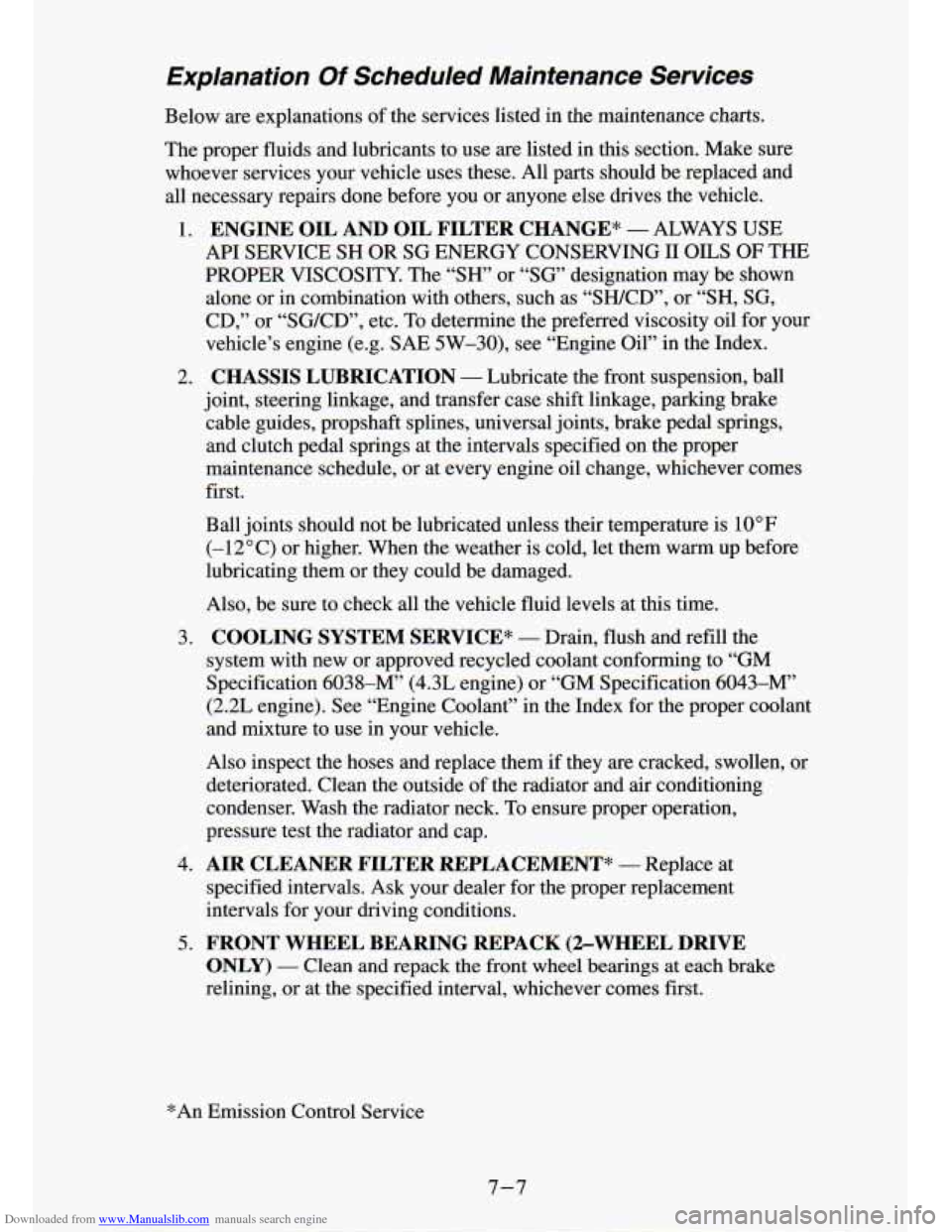
Downloaded from www.Manualslib.com manuals search engine Explanation Of Scheduled Maintenance Services
Below are explanations of the services listed in the maintenance charts.
The proper fluids and lubricants to use are listed
in this section. Make sure
whoever services your vehicle uses these. All parts should be \
replaced and
all necessary repairs done before you or anyone else drives the vehicle.
1. ENGINE OIL AND OIL FILTER CHANGE* - ALWAYS USE
API SERVICE SH OR SG ENERGY CONSERVING I1 OILS
OF THE
PROPER VISCOSITY. The “SH” or
“SG’ designation may be shown
alone or in combination with others, such as “SWCD”, or
“SH, SG,
CD,” or “SGKD”, etc. To determine the preferred viscosity oil for your
vehicle’s engine (e.g. SAE 5W-30), see “Engine
Oil” in the Index.
2. CHASSIS LUBRICATION - Lubricate the front suspension, ball
joint, steering linkage, and transfer case shift linkage, parking brake\
cable guides, propshaft splines, universal joints, brake pedal springs,
and clutch pedal springs at the intervals specified on the proper
maintenance schedule, or at every engine oil change, whichever comes
first
.
Ball joints should not be lubricated unless their temperature is 10°F
(-12°C) or higher. When the weather is cold, let them warm up before
lubricating them or they could be damaged.
Also, be sure
to check all the vehicle fluid levels at this time.
3.
COOLING SYSTEM SERVICE* - Drain, flush and refill the
system with new or approved recycled coolant conforming to “\
GM
Specification 6038-M” (4.3L engine) or “GM Specification 6043-M”
(2.2L engine). See “Engine Coolant” in the Index for the proper coolant
and mixture to use in your vehicle.
Also inspect the hoses and replace them if they are cracked, \
swollen, or
deteriorated. Clean the outside of the radiator and air conditioning
condenser. Wash the radiator neck. To ensure proper operation,
pressure test the radiator and cap.
4. AIR CLEANER FILTER REPLACEMENT* - Replace at
specified intervals. Ask your dealer for the proper replacement
intervals for your driving conditions.
5. FRONT WHEEL BEARING REPACK (%WHEEL DRIVE
ONLY) - Clean and repack the front wheel bearings at each brake
relining, or at the specified interval, whichever comes first.
*An Emission Control Service
7-7
Page 304 of 340

Downloaded from www.Manualslib.com manuals search engine 6. TRANSMISSION SERVICE:
Automatic Transmission
- Change the transmission fluid and filter
every
15,000 miles (25 000 km) he vehicle is mainly driven under
one or more of these conditions:
0 In heavy city traffic.
0 Where the outside temperature regularly reaches 90°F (32°C) or
0 In hilly or mountainous terrain.
0 Frequent trailer pulling. higher.
Uses such as taxi, police, delivery or other commercial service\
.
If the vehicle is not used mainly under any of these conditions, change
the fluid and filter every
30,000 miles (50 000 km). See “Automatic
Transmission Fluid” in the Index for more information.
Manual Transmission - Transrnission fluid does not require periodic
changing.
specified interval or sooner if clogged.
7. FUEL FILTER REPLACEMENT* - Replace the fuel filter at the
8. SPARK PLUG REPLACEMENT*$ - Replace spark plugs with the
type listed
in Section 6. Spark plugs (AC908) for the 2.2L Engine (VIN
Code 4) should be replaced every 100,000 miles (166 000 kilometers).
Spark plugs (.CR43TSM) for the 4.3L engines
(VIN Codes W and Z)
should be replaced every 30,000 miles (50 000 kilometers). See
‘‘Specification Charts” in the Index.
9. SPARK PLUG WIRE INSPECTION* - Clean wires and inspect
for burns, cracks or other damage. Check the wire boot fit at the
distributor and at the spark plugs. Replace wires as needed.
Adjust timing to underhood label specifications. Inspect the ins\
ide and outside
of the distributor cap and rotor for cracks, carbon tracking and
corrosion. Clean or replace as needed.
10. ENGINE TIMING CHECK AND DISTRIBUTOR CHECK*$ -
*An Emission Control Service
$=The California Air Resources Board has detennined that the fa\
ilure to
perform this maintenance item will not nullify the emission war\
ranty or limit recall liability prior to the completion
of vehicle usefui life. General
Motors, however, urges that all recommended maintenance services \
be
performed at the indicated intervals and the maintenance be rec\
orded.
7-8
Page 307 of 340
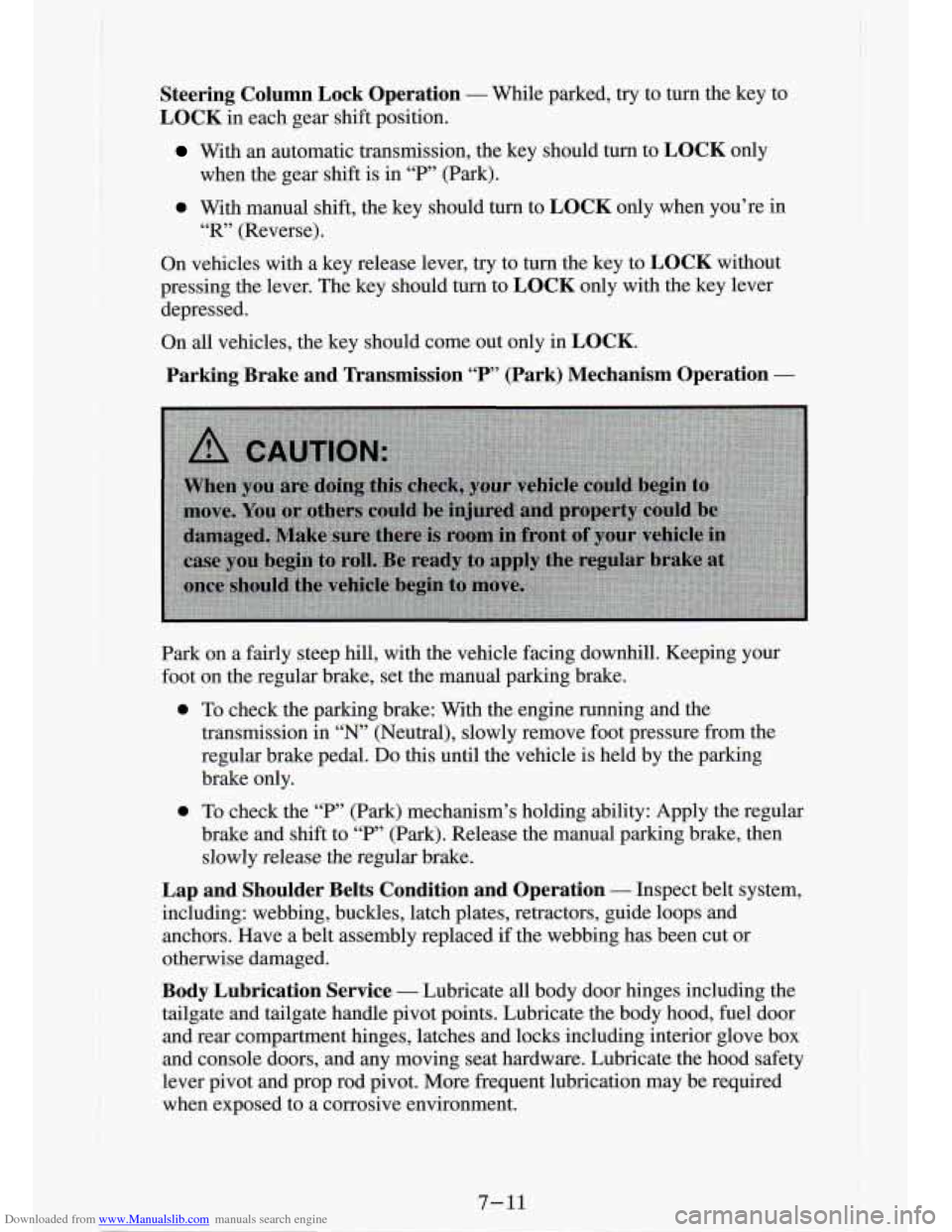
Downloaded from www.Manualslib.com manuals search engine Steering Column Lock Operation - While parked, try to turn the key to
LOCK in each gear shift position.
With an automatic transmission, the key should turn to LOCK only
0 With manual shift, the key should turn to LOCK only wnen you’re in
On vehicles with a key release lever, try to turn the key to
LOCK without
pressing the lever. The key should turn to
LOCK only with the key lever
depressed.
On
all vehicles, the key should come out only in LOCK.
when the gear shift is in “P’ (Park).
“R’ (Reverse).
Parking ‘Brake and Transmission “P’ (Park) Mechanism Operation -
Park on a fairly steep hill, with the vehicle facing downhill. Keeping your
foot on the regular brake, set the manual parking brake.
0
0 To check the parking brake: With the engine running and the
transmission
in “N” (Neutral), slowly remove foot pressure from the
regular brake pedal.
Do this until the vehicle is held by the parking
brake only.
To check the
“P’ (Park) mechanism’s holding ability: Apply the regular
brake and shift to
“P’ (Park). Release the manual parking brake, then
slowly release the regular brake.
Lap and Shoulder Belts Condition and Operation - Inspect belt system,
including: webbjng, buckles, latch plates, retractors, guide loops and
anchors. Have a belt assembly replaced
if the webbing has been cut or
otherwise damaged.
Body Lubrication Service - Lubricate all body door hinges including the
tailgate and tailgate handle pivot points. Lubricate the body hood, fuel door
and rear compartment hinges, latches and locks including interio\
r glove box
and console doors, and any moving seat hardware. Lubricate the \
hood safety
lever pivot and prop rod pivot.
More frequent lubrication may be required
when exposed to a corrosive environment.
7-11
Page 308 of 340
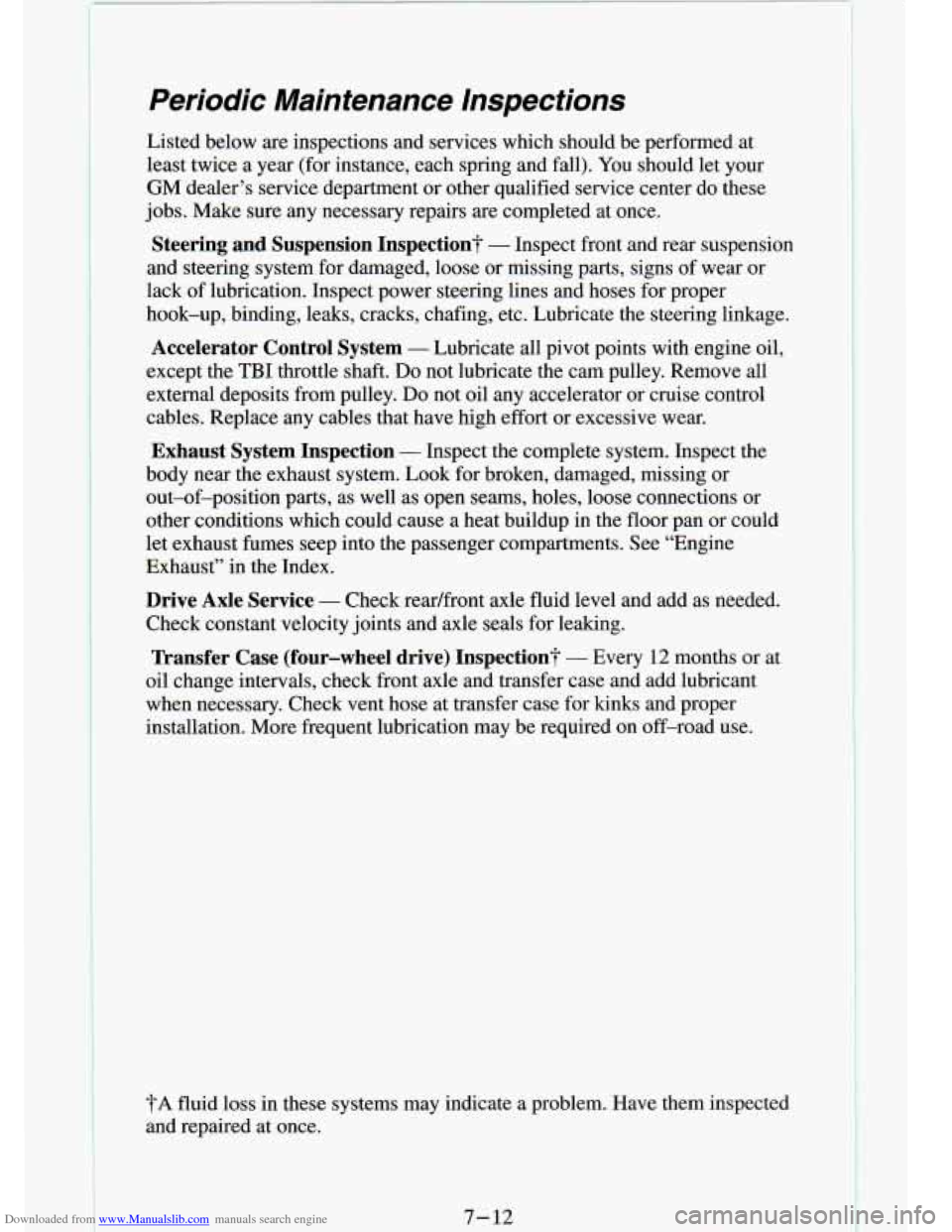
Downloaded from www.Manualslib.com manuals search engine Periodic Maintenance Inspections
Listed below are inspections and services which should be perfo\
rmed at
least twice a year (for instance, each spring and fall). You should let your
GM dealer’s service department or other qualified service center do these
jobs. Make sure any necessary repairs are completed
at once.
Steering and Suspension Inspection? - Inspect front and rear suspension
and steering system for damaged, loose or missing parts, signs of wear or
lack of lubrication. Inspect power steering lines and hoses for proper
hook-up, binding, leaks, cracks, chafing, etc.
Lu‘ ~ kate the steering linkage.
Accelerator Control System - Lubricate all pivot points with engine oil,
except the
TBI throttle shaft. Do not lubricate the cam pulley. Remove all
external deposits from pulley.
Do not oil any accelerator or cruise control
cables. Replace any cables that have high effort or excessive \
wear.
Exhaust System Inspection - Inspect the complete system. Inspect the
body near the exhaust system. Look for broken, damaged, missing
or
out-of-position parts, as well as open seams, holes, loose conn\
ections or
other conditions which could cause a heat buildup in the
floor pan or could
let exhaust fumes seep into the passenger compartments. See “Engine
Exhaust” in the Index.
Drive Axle Service - Check readfront axle fluid level and add as needed.
Check constant velocity joints and axle seals for leaking.
Transfer Case (four-wheel drive) Inspection? - Every 12 months or at
oil change intervals, check front axle and transfer case and add l\
ubricant
when necessary. Check vent hose at transfer case
for kinks and proper
installation. More frequent lubrication may be required on off-road use.
7- 12
?A fluid loss in these systems may indicate a problem. Have them inspected
and repaired at once.
Page 322 of 340
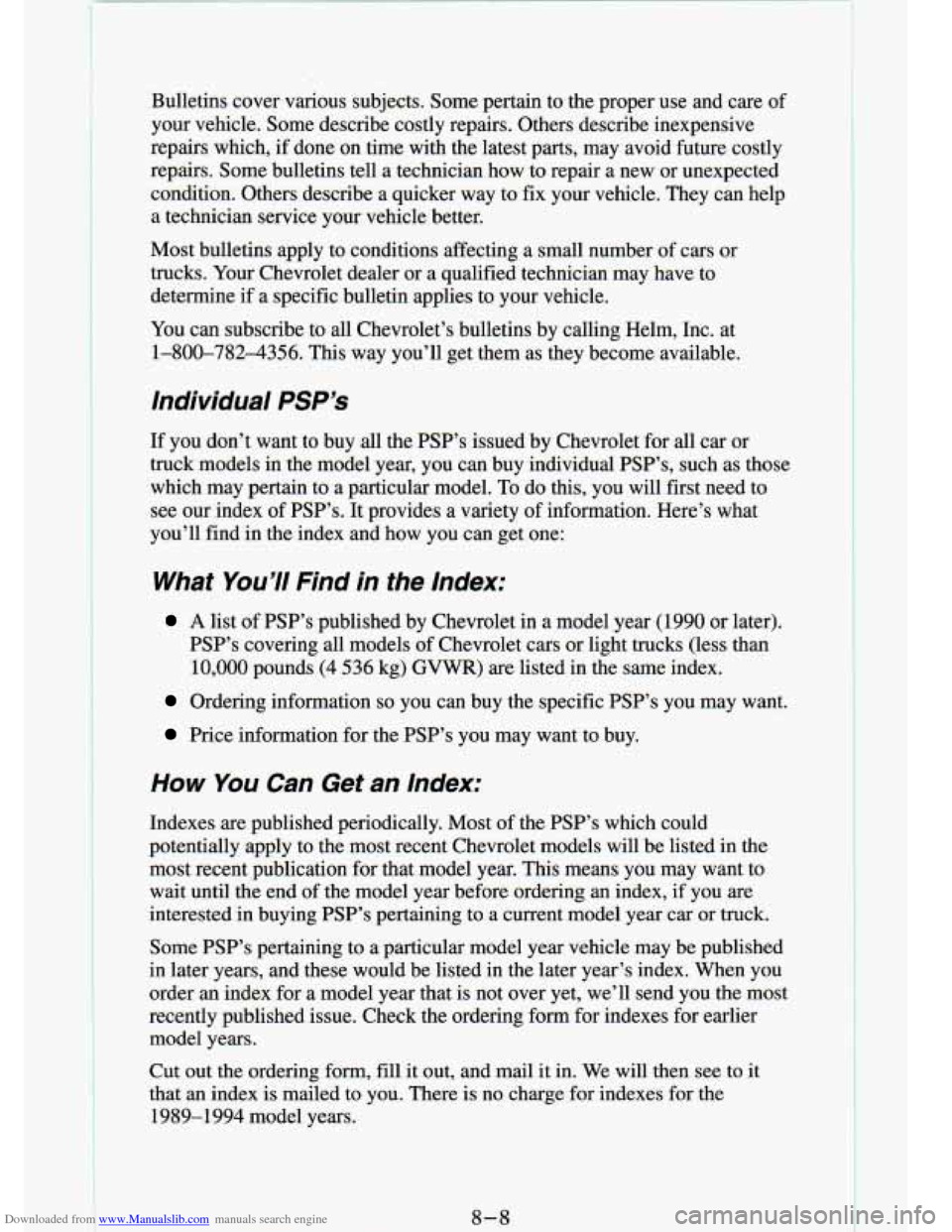
Downloaded from www.Manualslib.com manuals search engine Bulletins cover various subjects. Some pertain to the proper us\
e and care of
your vehicle. Some describe costly repairs, Others describe inex\
pensive
repairs which, if done on time with the latest parts, may avo\
id future costly
repairs. Some bulletins tell
a technician how to repair a new or unexpected
condition. Others describe
a quicker way to fix your vehicle. They can help
a technician service your vehicle better.
Most bulletins apply to conditions affecting a small number of cars or
trucks. Your Chevrolet dealer or a qualified technician may have to
determine if a specific bulletin applies to your vehicle.
You
can subscribe to all Chevrolet’s bulletins by calling Helm, Inc. at
1-800-782-4356. This way you’ll get them
as they become available.
mdividual PSP’s
li you don’t want to buy all the PSP’s issued by Chevrolet \
for au car67
truck models in the model year, you can buy individual PSP’s, such as those\
which may pertain to a particular model. To do this, you will first need to
see our index of PSP’s. It provides a variety of information. Here’s what
you’ll find in the index and how you can get one:
What You’ll Find in the Index:
A list of PSP’s published by Chevrolet in a model year (1990 or later).
PSP’s covering all models of Chevrolet cars or light trucks (less than
10,000 pounds (4
536 kg) GVWR) are listed in the same index.
Ordering information so you can buy the specific PSP’s you may want.
Price information for the PSP’s you may want to buy.
How You Can Get an Index:
Indexes are published periodically. Most of the PSP’s which could
potentially apply to the most recent Chevrolet models will be \
listed in the
most recent publication for that model year. This means you may want to
wait until the end
of the model year before ordering an index, if you are
interested in buying PSP’s pertaining to a current model year car or truck.
Some PSP’s pertaining to a particular model year vehicle may\
be published
in later years, and these would be listed
in the later year’s index. When you
order an index for a model year that is not over yet, we’ll send you the mos\
t
recently published~issue. Check the ordering form for indexes for earlier
model years.
Cut out the ordering form, fill it out, and mail it in. We will then see to it
that an index is mailed to you. There
is no charge for indexes for the
1989-1994 model years.
1
8-8- !
Page 327 of 340
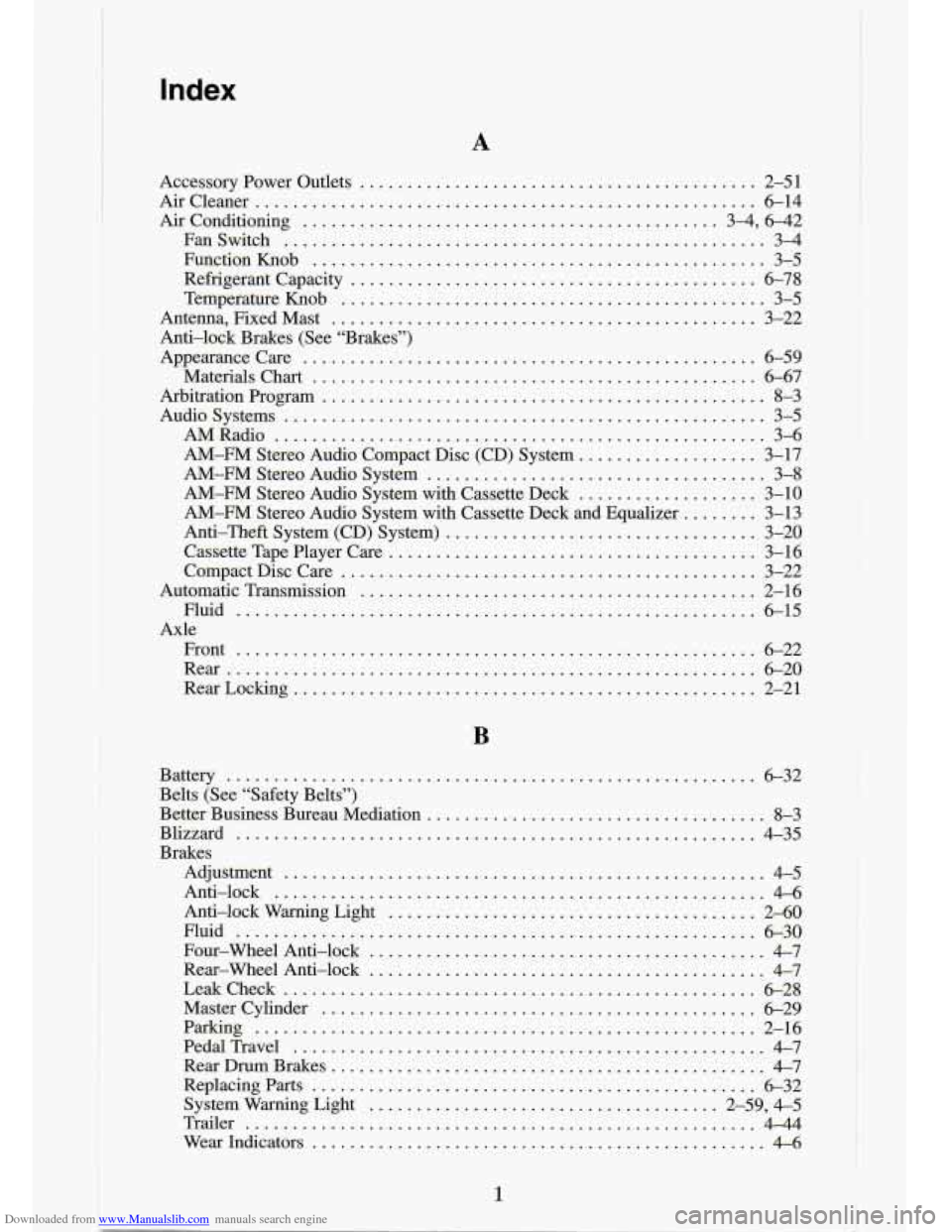
Downloaded from www.Manualslib.com manuals search engine Index
A
Accessory rower Outlets .......................................... 2-51
Aircleaner ..................................................... 6-14
Airconditioning
............................................ 3-4. 6-42
Fanswitch
................................................... 34
Functionhob
................................................ 3-5
Refrigerantcapacity
........................................... 6-78
Antenna. FixedMast
............................................. 3-22
Anti-lock Brakes (See “Brakes”)
Appearancecare
................................................ 6-59
Materials
Chart ............................................... 6-67
Arbitration Program
............................................... 8-3
Audiosystems
................................................... 3-5
AMRadio
.................................................... 3-6
AM-FM Stereo Audio Compact Disc (CD) System
................... 3-17
AM-FM Stereo Audio System
.................................... 3-8
AM-FM Stereo Audio System with Cassette Deck
................... 3-10
AM-FM Stereo Audio System with Cassette Deck and Equalizer ........ 3-13
Anti-Theft System (CD) System)
................................. 3-20
Cassette Tape Player Care
....................................... 3-16
CompactDiscCare
............................................ 3-22
Automatic Transmission
.......................................... 2-16
Axle Fluid
6-15
Front
....................................................... 6-22
Rear
........................................................ 6-20
Temperature Knob
............................................. 3-5
.......................................................
RearLocking ................................................. 2-21
B
Battery ........................................................ 6-32
Belts (See “Safety Belts”)
Better Business Bureau Mediation
.................................... 8-3
Blizzard
....................................................... 4-35
Brakes
Adjustment
................................................... 4-5
Anti-lock
.................................................... 4-6
Anti-lock Warning Light
....................................... 2-60
Fluid
....................................................... 6-30
Four-wheel Anti-lock
.......................................... 4-7
Rear-Wheel Anti-lock
.......................................... 4-7
Leakcheck .................................................. 6-28
Mastercylinder
.............................................. 6-29
Pedal Travel
.................................................. 4-7
RearDrumBrakes
.............................................. 4-7
Replacingparts
............................................... 6-32
System Warning Light
..................................... 2.59. 4-5
Trailer ...................................................... 444
Wear Indicators
................................................ 4-6
Paking
..................................................... 2-16